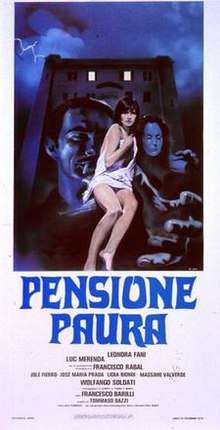Pensione paura
Pensione paura (lit. 'Hotel Fear') is a 1978 film directed by Francesco Barilli.[2][3]
| Pensione paura | |
|---|---|
 | |
| Directed by | Francesco Barilli |
| Produced by |
|
| Screenplay by |
|
| Story by |
|
| Starring | |
| Music by | Adolfo Waitzman[1] |
| Cinematography | Gualtiero Manozzi[1] |
| Edited by | Amedeo Salfa[1] |
Production companies |
|
| Distributed by | Euro International Film |
Release date |
|
Running time | 100 minutes[1] |
| Country |
|
Plot
A young girl and her mother run a hotel during the war. The girl finds herself at the mercy of her sex-crazed guests and matters become worse when her mother dies. Soon after, a cloaked figure starts killing off everyone that tries to harm her.
Cast
- Leonora Fani: Rosa
- Luc Merenda: Rodolfo
- Lidia Biondi: Marta
- Francisco Rabal: Marta's lover
- Jole Fierro: Rodolfo's lover
- Wolfango Soldati
- Máximo Valverde
Production
After directing The Perfume of the Lady in Black, it took four years for director Francesco Barilli to return to directing.[1] Barilli stated this was because he was not allowed to make the film he wanted to make, but was offered several different projects to work at.[1] One film Barilli wanted to make was titled L'occhio, when he was approached by producer Tommaso Dazzi who deemed L'occhio too expensive, and presented him with the treatment for Pensione paura.[1][4] Barilli admitted to needing the money and took the offer to direct the film.[4]
Filming started in Manziana in August 1977.[5] Barilli and producer Tommaso Dazzi often argued on set as Barilli shot scenes that were not in the script, which Barilli did not care for as he wanted to shoot the film the way he wanted to.[5]
The film had an unusual setting, which film historian Roberto Curti described as "one-of-a-kind work" that did not into the mold of a gothic, giallo, or psychological drama but encompassed elements of all the genres.[5]
Release
Pensione paura was distributed theatrically in Italy by Euro International Film on 16 February 1978.[1] The film grossed a total of 82,645,242 Italian lire domestically.[1] Curti described the film a commercial flop.[6] Barilli commented the producer who sold the film to Euro International Film which went bankrupt shortly after.[6] The film was released in Spain where it was promoted as an erotic film La violación de la señorita Julia.[6] It was Barelli's last theatrically released film, as the director dedicated himself to painting afterwards.[6]
See also
References
Footnotes
- Curti 2017, p. 196.
- Roberto Chiti; Roberto Poppi; Enrico Lancia. Dizionario del cinema italiano: I film. Gremese, 1991. ISBN 8876059695.
- Giancarlo Grossini. Dizionario del cinema giallo. Dedalo, 1985. ISBN 8822045106.
- Curti 2017, p. 197.
- Curti 2017, p. 198.
- Curti 2017, p. 200.
Sources
- Curti, Roberto (2017). Italian Gothic Horror Films, 1970–1979. McFarland. ISBN 1476629609.CS1 maint: ref=harv (link)